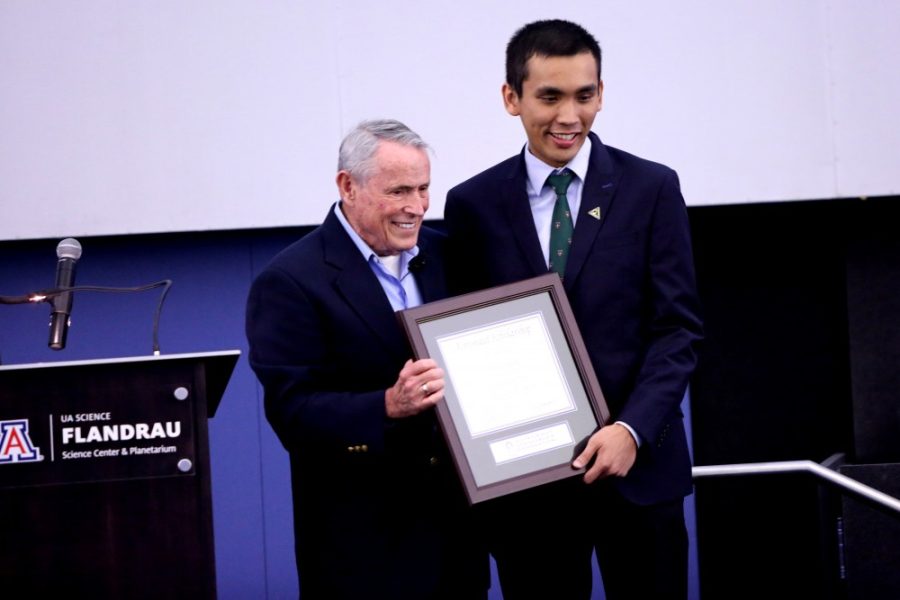Around 40 people reclined in the Flandrau Science Center and Planetarium’s newly renovated planetarium on Thursday evening, not to experience the usual FullDome show but to hear NASA astronaut Edward Gibson of Skylab 4 speak about his experiences in space.
Gibson is not only an astronaut, he is also the mentor of this year’s Astronaut Scholarship Award recipient Anson Cheung.
Cheung, a geosciences senior, said it was “really cool to be honored” and looks forward to all of the research opportunities awaiting him, as well as the connections he’ll have with NASA.
Cheung thanked his research mentors, Institute of the Environment Director Jonathan Overpeck and geosciences professor Julia Cole, who motivated him to go into the field, as well as the graduate students who helped him in his research.
Part of the honors college, Cheung’s honors thesis involves coral in the Galapagos Island, which he uses to reconstruct past El Niño events.
He spoke briefly to the crowd about his passion to understand climate change.
“I’d like to talk about the planet that’s a little closer to us—Earth,” Cheung said. “Earth cannot be viewed as only a planet. You have to understand different systems.”
He emphasized not only the importance of the systems but the importance of a historical reconstruction.
“You may wonder how the past is related to us,” Cheung said. “The thing is, to understand climate change you first need to understand the past. Through the past, you can understand the present and project the future.”
After Cheung’s remarks, Gibson presented him with a certificate and added a pin to his lapel.
“Anson understands the global nature of his work,” Gibson said. “He has many awards and publications—and I won’t try to list them all—but as an undergraduate, this is amazing. It’s always a little humbling, after I hear what these folks have done.”
While Cheung’s achievements humbled Gibson, Gibson’s achievements cast their own shadow.
“I had the privilege of looking back at the Earth for three months, and I’ve got to say, it really is the most beautiful planet,” Gibson said.
With plenty of jokes and anecdotes, Gibson held the audience spellbound as he described the entire procedure of being launched into space, comparing it to a day at the office.
RELATED: UA space sciences program ranks No. 7 in U.S. News & World Report’s Best Global Universities list
“Your office is located at the top of a 37-story building,” Gibson said. “You sit down and look at the lights flashing and computers blinking, and you realize that today the whole lifeless building has finally come alive, and you try to keep a wide grin off your face.”
He described the large sucking sound, the feel of eight engines igniting and the rocket creeping off the pad.
“There’s a whisper in the back of your mind saying, ‘Hey, you. You there. The basement of your building just exploded,’ “ Gibson said.
He categorized the first part of a launch as noisy and rough and the next part as a long, smooth elevator ride, though “your cheeks and ears have slid to the back of your head.”
“At eight minutes, the engines cut off really suddenly,” Gibson said. “All the dirt starts floating up from the floor they tried to keep so clean. A nut and some bolts float by and you try not to wonder where those came from.”
After entering the earth’s orbit, Gibson said the only thing to do is look down.
“One of the most natural things to do is to turn around and look at where you just came from,” Gibson said. “You turn and look out your window, and there’s Earth—you can’t miss it.”
As photos of a younger Gibson clicked by on the planetarium’s huge dome screen, Gibson gave a history of American space exploration. When photos of Gibson’s three spacewalks came across the screen, he paused and, for a moment, put all jokes aside.
“When you’re out there, it’s a silent world, expect for the whispers of your own breath,” Gibson said. “It feels like the world down there doesn’t even know you’re there.”
RELATED: UA research finds evidence supporting the existence of a ninth planet beyond Neptune
He swung back into comedy soon after, saying the only thing missing was a good pizza delivery service.
Gibson kept the crowd laughing with photo shopped images of aliens as he talked about dark matter, the expansion of the universe and how “empty space” is not empty at all.
“Space. It’s exciting, compelling and essential,” Gibson said. “When it comes to real space travel, we’ve barely nudged our collective toe out the front door.”
As an astronaut scholar, Cheung will help advance STEM in the U.S. with his work in climate research. The scholarship, worth $10,000, can be applied to both tuition and research.
Nicole Russ, Astronaut Scholarship Foundation program director, said the program started in 1984 with the Mercury 7 astronauts, who wanted to keep America on the front edge of technology.
Scholarship recipients are chosen by a panel, and the decision is based on merit and research. The UA, and other schools, submit two of their students for consideration.
“I’m always awed by how smart the recipients are,” Russ said. “I’m glad he’s the future.”
Follow Marissa Heffernan on Twitter.









